Mumbai Heritage Committee writes letter to MMRC about minor vibrations felt in the arm of 153-year-old statue atop fountain; hopes caution is exercised when drilling under adjacent parking lot to build Hutatma Chowk station
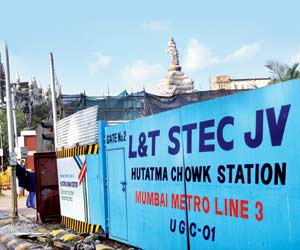
In 2015, the Jamshetjee Nessarwanjee Petit Institute and Library at Fort was the pride of Dr DN Road. The restoration of the 119-year-old building, had been recognised by the 2015 UNESCO Asia-Pacific Heritage Awards winners. But two years on, Petit has become more of a symbol of DN Road's concern. Will the construction of Line 3 of the Mumbai Metro project, extending from Seepz to Colaba, past the nearly kilometre-long stretch, cause irreparable damage to the heritage buildings that line the road and give it its unique identity?
ADVERTISEMENT
On August 25, a limestone finial, an ornamental piece on the Petit structure, fell off the building on the garden side from a height of 10 metres. Following this, the trustees of Petit moved the Bombay High Court, blaming the Metro construction, pleading that work on the same around the Neo Gothic structure be ceased till a comprehensive structural survey is undertaken. While the case came up for hearing on Friday — [see box: The Petit case] — concerns have emerged regarding other structures along the stretch.
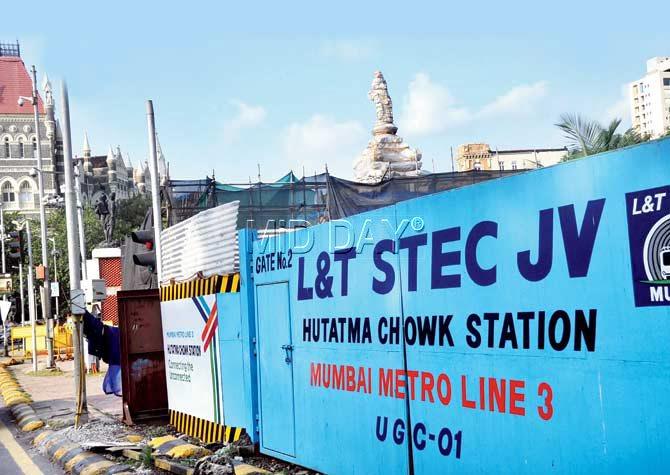
Despite a 100-metre distance from Metro work drilling, conservation experts suggest caution be exercised when working around Grade 1 heritage structures like Flora Fountain (centre) for its delicate masonry. Pic/Sayyed Sameer Abedi
A fragile fountain
In June this year, engineers with the Mumbai Heritage Conservation Committee, the heritage conservation arm of the Brihanmumbai Municipal Corporation shot off a letter to the Mumbai Metro Rail Corporation Limited — a part of the Mumbai Metropolitan Region Development Authority (MMRDA) which is looking after the construction and operation of the Metro Phase 3 — requesting that precautionary measures be taken to ensure that there's no damage to Flora Fountain, a Grade I heritage structure. The letter stated that during the execution of work, minor vibrations had been felt in the arms of the statue. The letter added that the vibrations could be due to influx of heavy traffic in the area.
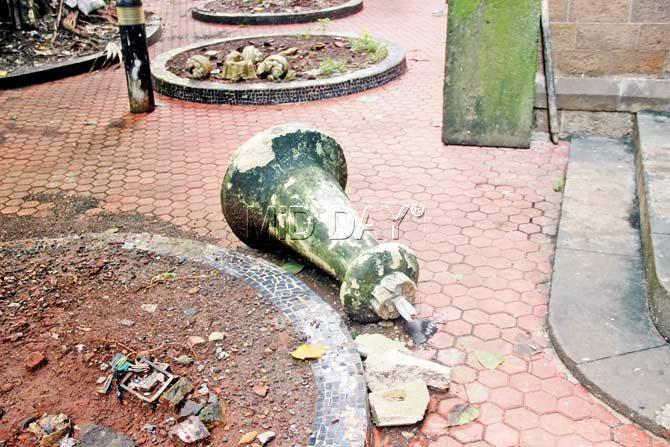
The broken finial at JN Petit Library's garden. Pic/Tanvi Phondekar
The fountain, which depicts the Roman goddess Flora, was built in 1864 at the spot where the church-side gate of the Old Mumbai Fort once stood. Conservation architect Vikas Dilawari, who is overseeing the restoration of the fountain along with BMC's heritage conservation cell and INTACH's Tasneem Mehta (Mumbai Chapter convenor and vice chairman), says that the fountain is a multi-tiered symmetric structure located in the centre of a round shallow basin. "On the topmost tier sculpted are celestial fish, in four corners, dripping water in the respective bowls. These bowls or troughs further cascade the water into lower tier troughs placed on the four corners of the fountain structure. Four life-size mythological figures are seen at the corners of the wider base spanned by semi-circular arches. The arches and cornice have carvings of foliage. The lower tier of the fountain is seen with a wide water collecting sink elevated by a number of round pillars in stone," he adds. The project is estimated to cost around Rs 3.5 crore While the Metro 3 line keeps a 100-metre distance from the fountain — from DN Road and the planned Hutatma Chowk Station near Petit Library, it veers to Churchgate Station — vibrations from the construction could pose a threat to the structure's delicate masonry work, says Sudarshan Shirsath, an MHCC official. "The small slender objects and sculptures on the fountain are essential components that need to be conserved," the letter that BMC sent says.
Conservation architect and director of Urban Design Research Institute, Pankaj Joshi, says the vibrations could dislocate the masonry. "The process is called delamination, where the stones loosen and come off in case of severe vibration. That can cause serious problem and result in a collapse. There's also the danger of pumping out too much water. Due to this, there are chances of small cavities developing below the heritage structure. You should be careful and ensure the water balance is maintained so that the sub soil water doesn't create empty pockets," he adds.
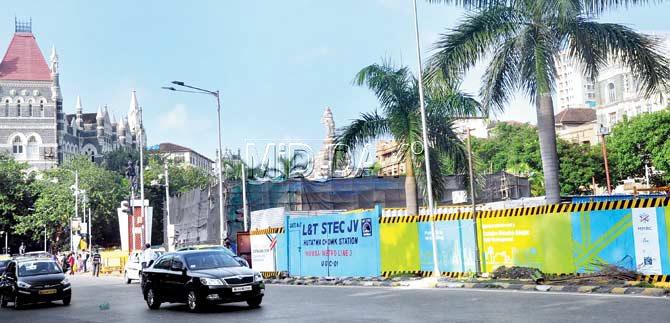
In June, the BMC wrote a letter to MMRC expressing worry that Flora Fountain, a Grade I heritage structure (centre), would be affected by the Metro construction. Pic/Sayyed Sameer Abedi
Maintaining quiet for the old
The letter from the MHCC to MRCC also shared concern that "during the progress of the work of Metro 3, specially in the car park area, adjoining the Grade I structure [of Flora Fountain], there will be additional vibrations emanating from the underground construction activity, especially due to the construction of proposed metro station — Hutatma Chowk, which may affect the monument."
Following the letter, BMC's A-ward office received a letter from the MMRC in August informing them that it would be monitoring heritage structures. A Nomis Seismograph (which measures vibrations and sound levels) has been installed at the fountain. Instruments to measure cracks (to check if they have widened) have been placed on the structure, and at other heritage buildings on the road. Work on DN Road is now in its sixth month.
Pankaj Joshi, a conservation architect, said, "The standard of sound decibel for the residential areas is around 50 dB, and there is no standard of vibration level as the buildings at that time were not designed for any kind of seismic activity." When mid-day asked MMRC what sound level is recorded near the Metro site, they refused to share their findings. Petit, which has filed a petition against the work, doesn't have a recording to share.
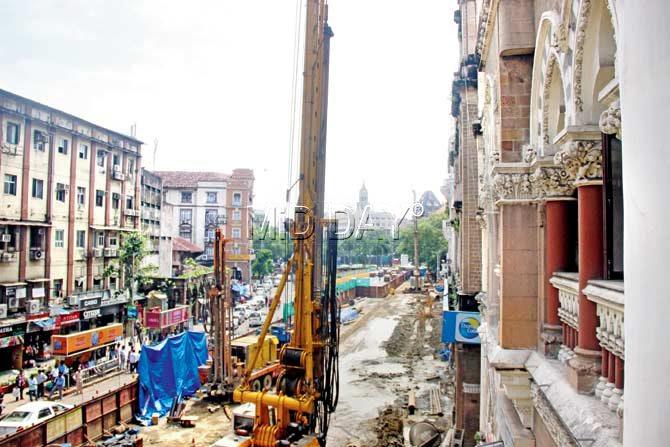
Work outside the 119-year-old JN Petit Library has been stayed until further notice by the Bombay High Court after a finial broke in August. Pics/Tanvi Phondekar
Cracks in the plan
While a structural survey of buildings was conducted when MMRC submitted its plan, including an assessment by conservation architects of how Metro 3 work might affect the heritage buildings along DN Road, the high court in September while hearing the Petit petition said it might ask the Indian Institute of Technology (Bombay) to conduct a structural survey of buildings on DN Road.
Farzana Behramkamdin, the advocate representing Petit in the court, says, "We are not opposing the Metro, but we are concerned about our heritage structures. We had a collapse of one of the ornamental pieces on August 25 and are concerned about the drilling and the piling work that is taking place, which may affect the structure. We wanted an entire re-survey done. Everything as per the survey reports done by MMRC at least with respect to our building, we know are defective and do not represent the building as it is." She adds that a three-member committee appointed by the court will visit Petit on Monday.
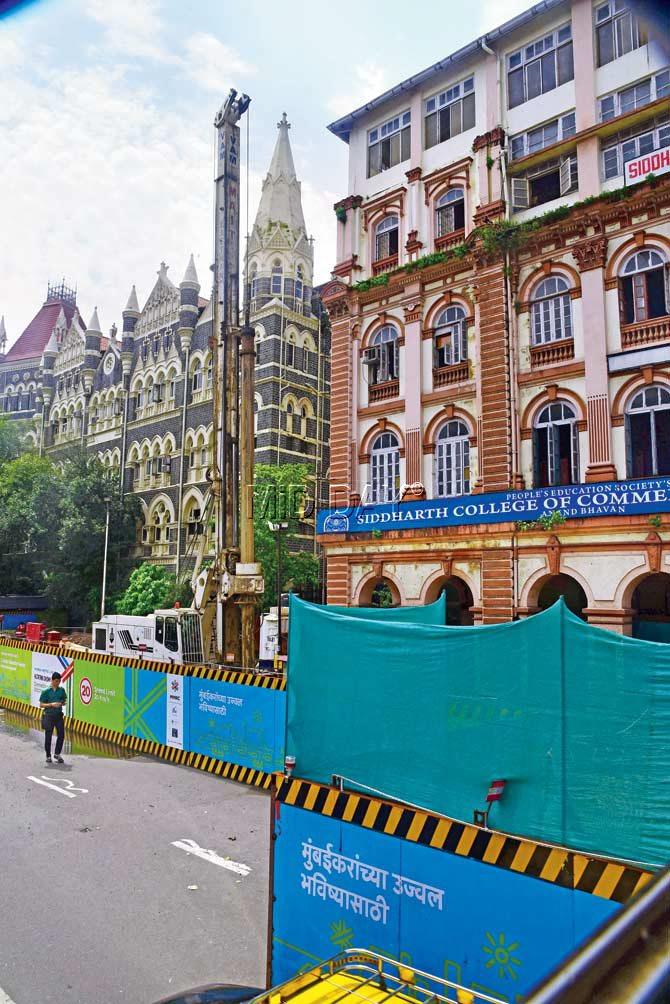
Drilling work continues outside the college building. Pics/Tanvi Phondekar
But it's not just Petit library that's waiting for a re-look.
Closer to Flora Fountain, ahead of Petit, lies the Siddharth College Of Arts Science & Commerce, housed in a 119-year-old structure.
The walls on each floor reach a height of 19 feet and many have cracks. College principal U Maske says the cracks were present even before the Metro work began, but now, they have started widening. "A private structural engineer who visited our college on Monday informed us that the cracks were widening," he says when we meet him at the college. According to MMRC's report, prepared in May 2017, at the time there were 30-odd cracks up to 3 mm wide, and five moderate cracks between 3 mm to 6 mm wide. However, says Maske, no assessment has been done about the whether new cracks have developed post Metro work and if existing cracks have widened.
He adds that the college's basement, the most affected area, has not been surveyed. "The cracks are widening and recently a small part of the pillar in the basement had also fallen. When we complain to the authorities, they responded saying that they are monitoring the cracks and there is nothing to worry about. There are over 4,500 students in my college and I cannot risk their lives by making them sit in classrooms where big cracks are developing."
He adds that no regular monitoring is taking place. "On Wednesday, there was loud noise and heavy vibrations owing to some piling work outside the college. The distance between the work site and college is not more than 10 feet. How does one teach?" The professors and non-teaching staff of the college will be sending a representation to the Chief Minister to stop work of Metro, stating that it would damage and endanger their college building.
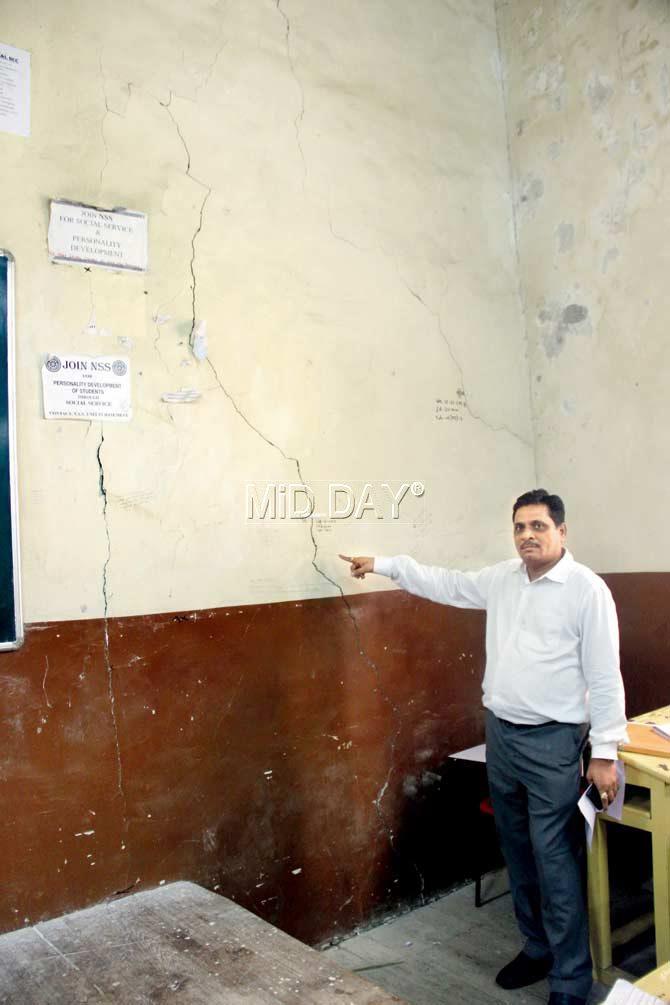
The principal of Siddharth College points to cracks on the college wall. He says while cracks have been around for a while, the Metro construction has led to their widening. In the basement, he says, a pillar fell recently
The track ahead
Yet, a city that urgently needs to decongest its existing public transportation systems, can't outrightly reject the Metro. Joshi says, "The city's heritage and new infrastructure work should co-exist. For this, whatever specials measures are needed should be taken."
He adds, "All countries have followed very strict standards when it comes to building a metro under a heritage structure. The London Tube and New York Metro are over 100 years old. They have been mindful that vibrations don't impact the edifice by ensuring that the water balance is maintained and the drilling is not too deep. Sensors need to be installed. It's really about discipline. We aren't the first to do this."
With inputs from Anju Maskeri
 Subscribe today by clicking the link and stay updated with the latest news!" Click here!
Subscribe today by clicking the link and stay updated with the latest news!" Click here!






